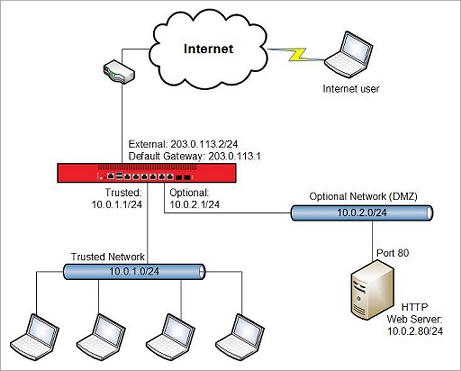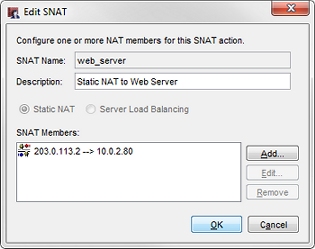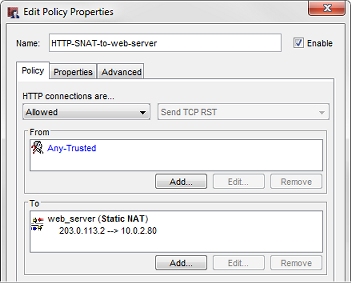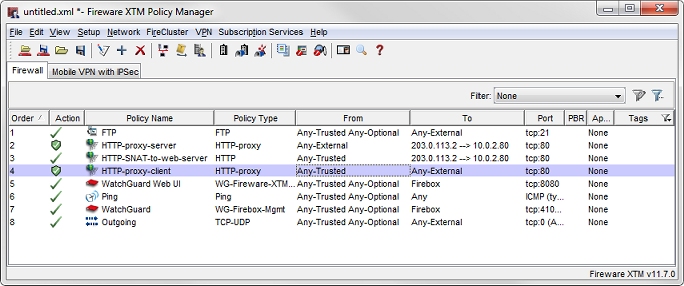The objective of this configuration example is to show how an organization can set up a public web server on a protected network behind the firewall. In this example, we want to direct incoming website traffic from the Internet to the private address of this web server. We also want local users on their own internal network to use the public URL to browse to this website.
This configuration example is provided as a guide. Additional configuration settings could be necessary, or more appropriate, for your network environment.
Solution Overview
When a computer sends traffic over the Internet to a server or another computer, it uses an IP address to identify the server, and a TCP or UDP port number to identify the process on the server that receives the data. Port 80 is used for HTTP traffic.
Network Address Translation (NAT) refers to any of several forms of IP address and port translation. Static NAT, also known as port forwarding, is a port-to-host NAT. When a packet comes in to a port on a Firebox interface, a static NAT action can change the destination IP address to a different IP address and port behind the firewall. Static NAT also operates on traffic sent from networks that your Firebox protects.
This solution uses a static NAT action in an HTTP-proxy policy to forward incoming traffic on port 80 to the private IP address of the web server located behind the Firebox. This is transparent to the Internet user.
In this example, the web server has a private IP address and is connected to a network behind an optional interface of the Firebox. In the public DNS record for this web server, the IP address associated with the web server is the external IP address of the Firebox.
The Firebox configuration should include an HTTP-proxy policy to handle all incoming port 80 traffic. The policy configuration should contain a static NAT action that tells the device to forward all incoming port 80 traffic to the private IP address of the web server on the optional network.
When an Internet user browses to the URL of the web server, the traffic comes in to the external interface of the Firebox on port 80. The HTTP-proxy policy receives the traffic and uses the IP address specified in the static NAT action to forward that web traffic to the web server.
Requirements
A Firebox
This configuration example is for a Firebox that runs Fireware v11.7.2 or higher.
A web server
An HTTP server configured as a public web server with a private IP address.
We recommend that you do not connect publicly accessible servers, such as a web server, FTP server, or mail server, to the same network that connects to internal users or other non-public network resources. Because these servers are publicly accessible, they represent a potential vulnerability to your internal network. Instead, connect these publicly accessible servers to a separate network from your other internal network resources and users. In this example, the web server should be part of a network connected to a Firebox configured as Optional, sometimes called the optional network.
Configuration
In our configuration example, the web server is located behind the Firebox on the optional network.

The Firebox and the web server use these IP addresses:
| Site A | |
|---|---|
| External interface IP address | 203.0.113.2/24 |
| Default Gateway IP address | 203.0.113.1 |
| IP address of the Firebox interface connected to the trusted network | 10.0.1.1/24 |
| IP address of the Firebox interface connected to the optional network | 10.0.2.1//24 |
| IP address of the web server on the optional network | 10.0.2.80/24 |
How It Works
Static NAT Action
In this example, we created a configuration with a static NAT action, also known as an SNAT action, to forward traffic from the public IP address of the Firebox external interface to the private IP address of the web server.
To view the static NAT action in Policy Manager:
- Start Policy Manager for the Firebox.
- Select Setup > Actions > SNAT.
- Create an SNAT action similar to our web_server action.

In this case, the static NAT action forwards packets addressed to the Firebox external interface IP address (203.0.113.2) to the private IP address of the web server (10.0.2.80). You can view and edit this static NAT action from within policies where it is used.
HTTP-Proxy Policy for Incoming Traffic to the Web Server
By default, the Firebox does not allow incoming traffic from the external interface to the trusted or optional networks. To allow the traffic to your web server, you must add either an HTTP packet filter or HTTP-proxy policy . We recommend you use the HTTP-proxy policy because it monitors the commands used in the connection to make sure they are in the correct syntax and order, and uses deep packet inspection to help protect your HTTP server from attacks. For each proxy policy, you assign a proxy action that contains rules about what kind of content to allow. The rules in the HTTP-Server proxy action are good defaults for traffic to an internal web server.
To view the HTTP-proxy policy in Policy Manager:
- Open a configuration file in Policy Manager.
- Create an HTTP-proxy-server policy similar to ours.

Make sure you understand these settings:
From
The From section contains the Any-External alias, because this policy handles traffic that comes in to the web server from the external interface.
To
The To section contains the static NAT action that forwards packets addressed to the Firebox external interface IP address (203.0.113.2) to the private IP address of the web server (10.0.2.80).
Proxy action
The Proxy action is set to HTTP-Server.Standard. The default settings in the HTTP-server proxy action are the recommended default settings for traffic to a web server.
HTTP Policy to Allow Internal Users to Use the Public Web Server URL
Our configuration contains an HTTP policy to allow the internal users to browse to the web server by its public domain name, such as www.example.com. The HTTP policy handles traffic from the trusted network to the local web server. This policy includes the same static NAT action as in the HTTP-proxy-server policy. Because this policy handles only internal traffic, there is no need for deep packet inspection, so we use the HTTP packet filter policy instead of the HTTP-Proxy policy.
To view the HTTP NAT policy in Policy Manager:
- Open a configuration file in Policy Manager.
- Create a HTTP-SNAT-to-web-server policy similar to our policy.
For more information, go to Configure Static NAT (SNAT).

This policy includes:
From
The From section of the policy allows traffic from Any-Trusted.
To
The To section contains the same static NAT action to forward packets addressed to the Firebox external interface IP address (203.0.113.2) to the private IP address of the web server (10.0.2.80).
This policy uses the static NAT action for traffic from users on the trusted network.
If the network has a local DNS server with a split DNS configuration, you can add a DNS record to the internal zone to map the public domain name of the web server to its private IP address. If you do this, the HTTP policy with the SNAT action is not necessary.
HTTP-Proxy Policy for Outbound Web Requests
Our example configuration also includes an HTTP-proxy policy to control outbound web server access. This is not related to configuration of the web server on the optional network, but is a policy you would typically use to apply HTTP-proxy settings to outbound HTTP access for users on the trusted network. This policy allows HTTP traffic from Any-Trusted to Any-External. In our example, that policy is named HTTP-proxy-client.

Conclusion
In this configuration example, the Internet user browses to 203.0.113.2, or to a URL that resolves to that IP address. The traffic enters the Firebox external interface on port 80. The HTTP-proxy-server policy inspects the incoming traffic on the external interface and forwards that traffic to the HTTP server on the private network address, 10.0.2.80. Responses from the web server appear to the Internet user to come from IP address 203.0.113.2.
This configuration example demonstrates how to use static NAT to send web traffic to an HTTP server on a protected network. You can also use static NAT in other policies to redirect incoming traffic to other internal servers, such as an FTP server or an SMTP email server.